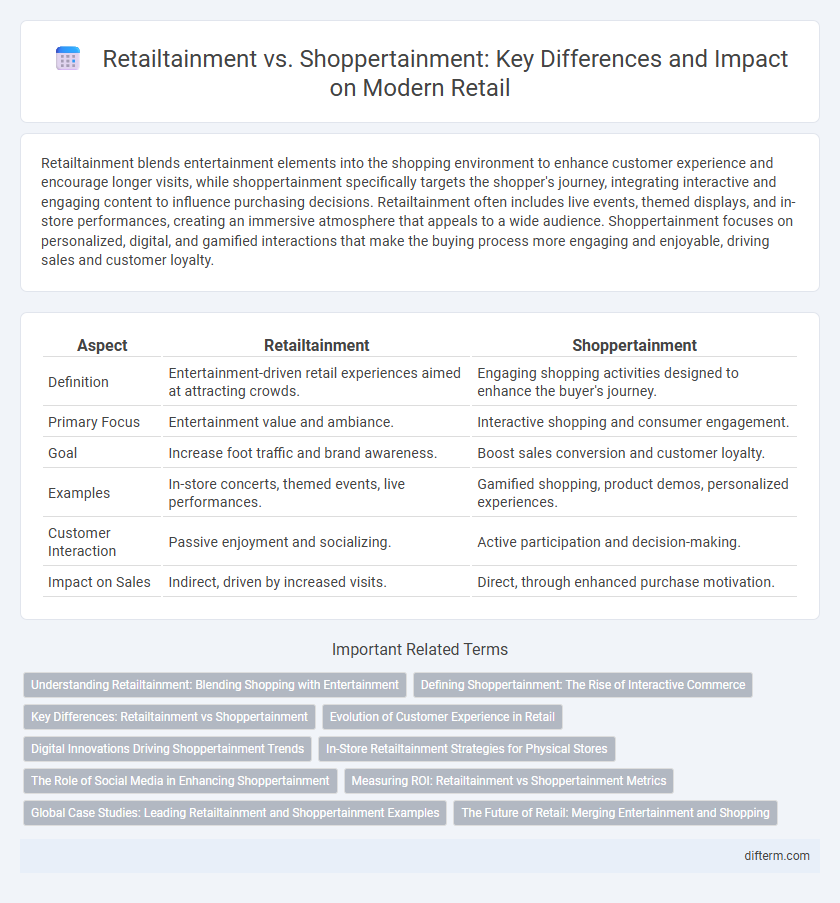Retailtainment blends entertainment elements into the shopping environment to enhance customer experience and encourage longer visits, while shoppertainment specifically targets the shopper's journey, integrating interactive and engaging content to influence purchasing decisions. Retailtainment often includes live events, themed displays, and in-store performances, creating an immersive atmosphere that appeals to a wide audience. Shoppertainment focuses on personalized, digital, and gamified interactions that make the buying process more engaging and enjoyable, driving sales and customer loyalty.
Table of Comparison
| Aspect | Retailtainment | Shoppertainment |
|---|---|---|
| Definition | Entertainment-driven retail experiences aimed at attracting crowds. | Engaging shopping activities designed to enhance the buyer's journey. |
| Primary Focus | Entertainment value and ambiance. | Interactive shopping and consumer engagement. |
| Goal | Increase foot traffic and brand awareness. | Boost sales conversion and customer loyalty. |
| Examples | In-store concerts, themed events, live performances. | Gamified shopping, product demos, personalized experiences. |
| Customer Interaction | Passive enjoyment and socializing. | Active participation and decision-making. |
| Impact on Sales | Indirect, driven by increased visits. | Direct, through enhanced purchase motivation. |
Understanding Retailtainment: Blending Shopping with Entertainment
Retailtainment combines shopping with immersive entertainment experiences aimed at increasing customer engagement and dwell time. This strategy integrates interactive displays, live performances, and themed events to create memorable retail environments that drive foot traffic and enhance brand loyalty. Understanding retailtainment is essential for retailers seeking to differentiate their stores and boost sales through experiential marketing.
Defining Shoppertainment: The Rise of Interactive Commerce
Shoppertainment redefines retail by integrating interactive commerce elements that actively engage consumers through immersive experiences, such as augmented reality and live streaming. This approach transforms shopping into an entertainment-driven activity, increasing customer dwell time and boosting conversion rates. Retailers leveraging shoppertainment create personalized, multisensory interactions that blend social engagement with seamless purchasing pathways.
Key Differences: Retailtainment vs Shoppertainment
Retailtainment integrates entertainment elements directly into the shopping environment to enhance the overall customer experience and increase dwell time. Shoppertainment combines shopping and entertainment by engaging customers interactively through immersive experiences, often leveraging technology and social media. The key difference lies in retailtainment focusing on in-store ambiance and activities, while shoppertainment emphasizes consumer participation and digital engagement.
Evolution of Customer Experience in Retail
Retailtainment integrates entertainment elements directly into the shopping environment, enhancing sensory engagement and extending customer dwell time. Shoppertainment evolves this concept by embedding interactive, personalized experiences through digital technologies like AR and VR, driving deeper emotional connections and increased purchase intent. Both strategies underscore the shift from transactional retail to experiential consumption, emphasizing customer immersion and brand loyalty.
Digital Innovations Driving Shoppertainment Trends
Digital innovations such as augmented reality, artificial intelligence, and personalized mobile apps are reshaping shoppertainment by creating immersive and interactive shopping experiences that blend entertainment with retail. These technologies enable retailers to engage customers through gamification, virtual try-ons, and real-time customization, driving higher engagement and conversion rates. The integration of data analytics further enhances personalization, making shoppertainment a crucial strategy for retailers aiming to differentiate in competitive markets.
In-Store Retailtainment Strategies for Physical Stores
In-store retailtainment strategies emphasize immersive, interactive experiences such as live demonstrations, themed events, and augmented reality installations to engage shoppers and increase dwell time. Shoppertainment, combining entertainment with shopping convenience, integrates digital touchpoints like interactive kiosks and personalized mobile apps to enhance customer interaction and drive sales conversion. Physical stores leveraging these immersive techniques create multisensory environments that encourage exploration, social interaction, and brand loyalty, optimizing foot traffic and overall revenue growth.
The Role of Social Media in Enhancing Shoppertainment
Social media platforms amplify shoppertainment by creating interactive and engaging retail experiences that blend entertainment with shopping, driving higher customer engagement and brand loyalty. Features like live streaming, shoppable posts, and user-generated content enable retailers to showcase products dynamically and foster real-time interaction. Leveraging social media analytics allows brands to tailor shoppertainment strategies, optimizing customer journeys and increasing conversion rates.
Measuring ROI: Retailtainment vs Shoppertainment Metrics
Measuring ROI in retailtainment focuses on customer engagement metrics such as foot traffic, average dwell time, and in-store event participation, reflecting experiential impact on sales. Shoppertainment ROI emphasizes conversion rates, basket size, and repeat purchase frequency, capturing the direct influence on transactional behavior. Both approaches require integrated data analytics to optimize marketing effectiveness and enhance customer lifetime value.
Global Case Studies: Leading Retailtainment and Shoppertainment Examples
Global retailtainment successes include Nike's flagship stores featuring immersive experiences and interactive basketball courts, driving deeper customer engagement and brand loyalty. Shoppertainment is exemplified by Alibaba's Singles' Day, blending live-streaming, gamification, and real-time purchasing to create a dynamic shopping environment that boosts sales and customer retention. Both strategies leverage technology and experiential marketing to transform traditional retail into engaging, multisensory experiences that enhance consumer interaction worldwide.
The Future of Retail: Merging Entertainment and Shopping
Retailtainment enhances the shopping experience by integrating interactive entertainment elements within physical stores, boosting customer engagement and dwell time. Shoppertainment advances this concept by blending digital technologies such as virtual reality and personalized content to create seamless, immersive shopping journeys. The future of retail hinges on merging entertainment and shopping to foster emotional connections and drive sales through experiential, technology-driven environments.
Retailtainment vs Shoppertainment Infographic

 difterm.com
difterm.com